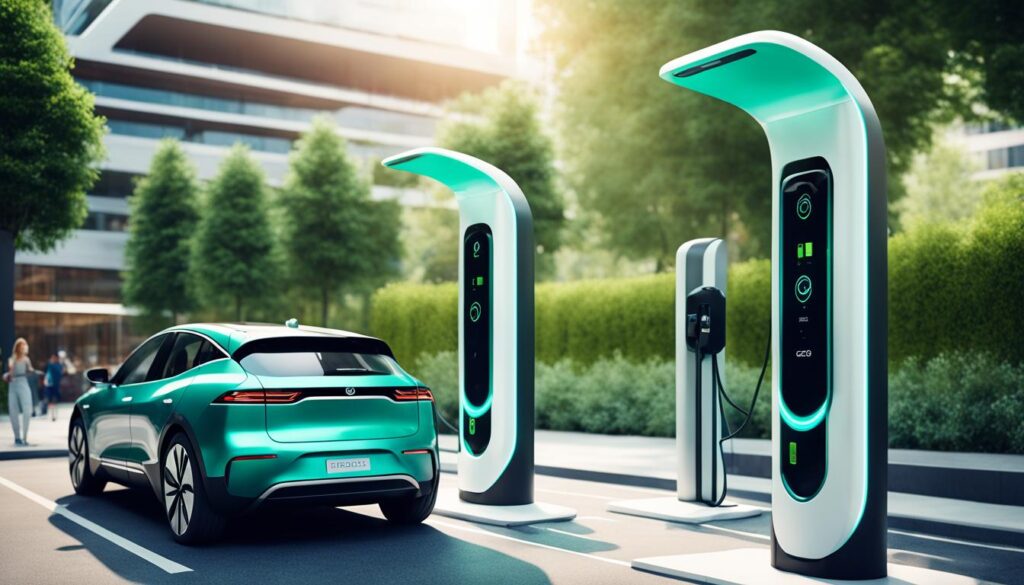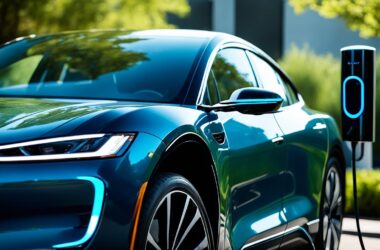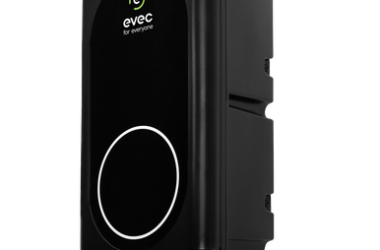Untethered charging points are revolutionizing the way we access power for our devices. These wireless charging stations provide a seamless and efficient way to charge your devices on the go, without the need for cords or cables. With the convenience and flexibility they offer, untethered charging points are becoming increasingly popular in homes, businesses, and public spaces. In this article, we will explore the benefits and options of untethered charging points, helping you understand why they are the future of power access.
Key Takeaways:
- Untethered charging points provide a convenient and cord-free way to charge devices.
- These wireless charging stations are becoming increasingly popular in various settings.
- Untethered charging points offer flexibility and efficiency for power access.
- They eliminate the need for cords or cables, making charging more seamless.
- With untethered charging points, the future of power access is wireless and contactless.
Tethered vs Untethered EV Chargers: Choosing the Right Option
When it comes to EV chargers, you have the option to choose between tethered and untethered charging. Tethered EV chargers come with a built-in cable permanently connected to the charging unit. On the other hand, untethered EV chargers require you to use your own cable to connect your car to the charging port. Both options have their pros and cons, and we will take a closer look at each to help you make an informed decision.
Tethered Charging
A tethered charger has a fixed cable attached to the charging unit, providing a convenient and ready-to-use solution for charging your electric vehicle. The built-in cable ensures that you always have a charging connection available, eliminating the need to bring your own cable.
“Tethered EV chargers offer a hassle-free charging experience. The built-in cable provides convenience and saves you from carrying an additional cable with you.”
However, tethered chargers may have limitations in terms of cable length, which can impact the flexibility of charging your vehicle, especially if your parking space is far from the charging unit. Additionally, the built-in cable may be prone to wear and tear over time, requiring the entire unit to be replaced if the cable becomes damaged. This can result in increased maintenance costs.
Untethered Charging
An untethered charger does not come with a built-in cable. Instead, you are required to provide your own cable to connect your car to the charging port. This gives you the flexibility to choose the cable length and type that best suits your needs.
“Untethered EV chargers offer greater flexibility and customization options. You have the freedom to use the cable of your choice and can easily replace it if needed.”
However, the use of your own cable means that you need to ensure you always have it with you when you need to charge your vehicle. Forgetting or losing the cable can result in inconvenience and the inability to charge your EV. Additionally, untethered chargers may not have the same visual appeal as tethered chargers, as the cables can be prone to tangling and create a less tidy charging setup.
Choosing the Right Option
When deciding between tethered and untethered charging, there are a few factors to consider:
- Convenience: Tethered charging offers a hassle-free experience with a built-in cable, while untethered charging provides flexibility and customization.
- Flexibility: Untethered charging allows you to choose the cable length and type, ensuring compatibility with your specific charging needs.
- Maintenance: Tethered chargers may require more maintenance if the built-in cable becomes damaged, while untethered chargers provide easier cable replacement.
- Portability: Untethered chargers are more portable as they do not have a permanently attached cable, making it easier to transport and install.
Ultimately, the decision between tethered and untethered charging depends on your individual preferences, charging requirements, and the specific setup of your charging location. Consider factors such as convenience, cable flexibility, maintenance needs, and portability to choose the right option for your EV charging needs.
| Tethered Charging | Untethered Charging |
|---|---|
| Convenient with built-in cable | Flexibility to choose cable length and type |
| Limited cable length | Risk of forgetting or losing the cable |
| Potential maintenance costs | Easier cable replacement |
| May have visual appeal | Less tidy charging setup |
**Updated Table**
| Tethered Charging | Untethered Charging |
|——————–|———————–|
| Convenient with built-in cable | Flexibility to choose cable length and type|
| Limited cable length | Risk of forgetting or losing the cable |
| Potential maintenance costs| Easier cable replacement |
| May have visual appeal | Less tidy charging setup |
Pros and Cons of Tethered EV Chargers
When considering EV chargers, tethered charging is one option to explore. Tethered EV chargers provide the convenience of having the charging cable always available, offering a hassle-free charging experience. This can be especially beneficial for those who frequently charge their electric vehicles and prefer not to carry a separate cable.
One of the main benefits of tethered charging is that it typically comes with a higher quality built-in cable. This ensures stable and reliable charging, minimizing the risk of cable damage and power interruptions. In addition, the built-in cable is always ready for use, saving time and effort in searching for and connecting external cables.
However, there are some drawbacks to consider when opting for a tethered EV charger. The visual appeal of the charger may be affected, as the built-in cable is always visible. This can be a concern for those who prioritize aesthetics or have specific design preferences for their EV charging setup.
Organizing the cable can also be a challenge with tethered charging. It may require additional effort to keep the cable neatly arranged, especially if it is long or if there are multiple cables in use. This can be particularly problematic for individuals with limited space or for public charging stations that aim to maintain a tidy and organized environment.
Another limitation of tethered charging is the cable length. The built-in cable may not always be long enough to reach the charging port of the electric vehicle, especially in off-street parking situations or when the charging point is located further away. This can restrict the flexibility and convenience of charging, requiring alternate positioning of the vehicle or the installation of additional charging infrastructure.
Overall, while tethered EV chargers offer the benefit of a readily available charging cable and a high-quality charging experience, they may not suit every situation. It’s important to carefully consider the visual, organizational, and logistical aspects before deciding on the right charging solution for your electric vehicle.
Pros and Cons of Tethered EV Chargers
| Pros | Cons |
|---|---|
| Always available charging cable | Affects visual appeal of the charger |
| Higher quality built-in cable | Challenging to keep the cable organized |
| Limitation in cable length for off-street parking |
Pros and Cons of Untethered EV Chargers
Untethered EV chargers offer a range of benefits and drawbacks. Understanding these key aspects will help you make an informed decision when choosing the right EV charging option for your needs.
Benefits of Untethered Charging
- Flexibility: Untethered EV chargers provide more flexibility compared to tethered chargers. With no built-in cable, you have the freedom to choose and upgrade your own charging cable as needed.
- Easy Installation: Untethered chargers are often cheaper and easier to install, thanks to their simple design. Without a built-in cable, the installation process becomes more streamlined.
- Tidier Look: With no bulky built-in cable, untethered chargers offer a cleaner and more aesthetically pleasing appearance, enhancing the overall look of your charging setup.
Drawbacks of Untethered Charging
- Personal Cable Requirement: Unlike tethered chargers, untethered chargers require you to provide your own charging cable. This can be inconvenient and increases the risk of losing or forgetting your cable.
- Additional Step: Untethered charging adds an extra step to the charging process. You need to connect your own cable to the charging port, which may be less convenient compared to tethered chargers where the cable is always ready for use.
Despite these drawbacks, untethered EV chargers remain a popular choice for many due to the flexibility, tidier installation, and cleaner look they offer.

| Benefits of Untethered Charging | Drawbacks of Untethered Charging |
|---|---|
| Flexibility | Personal Cable Requirement |
| Easy Installation | Additional Step |
| Tidier Look |
Factors to Consider When Choosing an EV Charger
When it comes to choosing an EV charger, there are several important factors to consider beyond whether it is tethered or untethered. These factors will help you make an informed decision and ensure that your charging experience is efficient and convenient.
Installation Location
One crucial factor to consider is the installation location of your EV charger. You need to determine where it will be installed, taking into account factors such as accessibility and proximity to your electrical panel. Choosing a location that is easily accessible will make charging your EV more convenient and hassle-free.
Charging Speed
Another important factor to consider is the charging speed of the EV charger. Different chargers offer varying charging speeds, and it’s essential to choose one that aligns with your needs. If you require faster charging times, you may opt for a charger with higher wattage or one that supports fast charging technology.
Charging Levels
Understanding the different charging levels is crucial when selecting an EV charger. There are three main charging levels: Level 1, Level 2, and Level 3 (DC Fast Charging). Each level provides varying charging speeds and requires different hardware. Evaluating your charging requirements and the capabilities of your EV will help you determine the appropriate charging level.
Other High-Quality Features
When choosing an EV charger, it’s worth considering other high-quality features that can enhance your charging experience. Some chargers offer advanced monitoring capabilities, allowing you to track and manage your charging sessions efficiently. Additionally, features such as locking mechanisms and earthing systems provide added security and peace of mind.
| Factors to Consider | Explanation |
|---|---|
| Installation Location | Determining the ideal location for your EV charger based on accessibility and proximity to your electrical panel. |
| Charging Speed | Considering the desired charging speed and choosing a charger that aligns with your requirements. |
| Charging Levels | Understanding the different charging levels available and choosing the appropriate level for your EV and charging needs. |
| Other High-Quality Features | Exploring additional features such as monitoring capabilities, locking mechanisms, and earthing systems to enhance your charging experience. |
By considering these factors when choosing an EV charger, you can ensure that you select the right charger for your needs, providing you with a reliable and efficient charging solution for years to come.
Project EV Charger Features: Innovative Solutions
Project EV offers a range of innovative EV chargers with features designed to enhance your charging experience. Our chargers are equipped with cutting-edge technologies that prioritize efficiency, convenience, and sustainability. Let’s explore some of the standout features that make Project EV chargers a top choice for electric vehicle owners.
Pro Earth Charging Range
One of the standout features of Project EV chargers is our Pro Earth charging range. With Pro Earth, you no longer need an additional earth spike, which reduces costs and simplifies installation. This innovative solution streamlines the charging process, making it more convenient and cost-effective for both residential and commercial setups.
Solar Compatibility
At Project EV, we understand the importance of renewable energy sources. That’s why our chargers are solar-compatible, allowing you to charge your vehicle using clean and green energy. By harnessing the power of the sun, you can reduce your carbon footprint and contribute to a more sustainable future. Embrace solar compatibility with Project EV chargers and take a step towards a greener tomorrow.
Cable Lock System
We prioritize the security of your charging cable with our advanced cable lock system. Our chargers are equipped with a state-of-the-art locking mechanism, offering peace of mind and ensuring that your charging cable is always protected. With the cable lock system, you can confidently leave your vehicle charging unattended, knowing that your cable is secure.
Dynamic Load Balancing
Efficient energy distribution is a key feature of Project EV chargers. Our chargers are equipped with dynamic load balancing technology, ensuring optimal power allocation among multiple charging points. This intelligent system prioritizes charging based on the available power capacity, making the most of your electrical resources and optimizing charging times.
Simultaneous Multi-Vehicle Charging
If you have multiple electric vehicles or share your charging station with others, Project EV chargers have got you covered. Our chargers are designed to support simultaneous charging of multiple vehicles, allowing you to make the most of your charging infrastructure. Say goodbye to long queues and waiting times by embracing the convenience of multi-vehicle charging.
Full Compliance with Electrical Regulations
When it comes to electrical safety, there is no compromise. Project EV chargers are fully compliant with all relevant electrical regulations and standards. We prioritize the safety of our users and ensure that our chargers meet the highest industry standards, giving you peace of mind and confidence in your charging experience.
With these innovative features, Project EV chargers deliver a seamless and user-friendly EV charging experience. From streamlining installation with Pro Earth to enabling solar compatibility and ensuring cable security, our chargers are designed to meet your specific needs. Embrace the future of electric vehicle charging with Project EV and enjoy the convenience, efficiency, and sustainability of our innovative solutions.
| Features | Benefits | |
|---|---|---|
| Pro Earth Charging Range | – Eliminates the need for an additional earth spike | – Reduces costs and simplifies installation |
| Solar Compatibility | – Charges your vehicle using green energy | – Reduces carbon footprint |
| Cable Lock System | – Ensures the security of your charging cable | – Provides peace of mind |
| Dynamic Load Balancing | – Optimizes power allocation among charging points | – Reduces charging times |
| Simultaneous Multi-Vehicle Charging | – Supports charging multiple vehicles simultaneously | – Eliminates waiting times |
| Full Compliance with Electrical Regulations | – Ensures safety and peace of mind | – Meets industry standards |

Control and Convenience with Project EV Chargers
Project EV chargers offer a range of control and convenience options, making your EV charging experience seamless and user-friendly. With features like the Project EV app, RFID control, plug and charge, and smart charging options, you have full control over your charging process.
Customize Charging Rates with the Project EV App
The Project EV App allows you to personalize your charging rates according to your preferences. Whether you want to prioritize off-peak charging to take advantage of cost savings or adjust the charging speed based on your needs, the app gives you the flexibility to customize your charging experience.
Simplify Charging with RFID Control
With RFID control, starting and stopping your charging cycles is as simple as swiping a card. This added security feature ensures that only authorized individuals can use your EV charger, providing peace of mind and safeguarding against unauthorized access.
Convenient Plug and Charge Feature
Project EV chargers come equipped with the plug and charge feature, eliminating the need for additional software or applications to control your EV charge point. Simply plug in your vehicle, and the charging process will commence automatically, offering a hassle-free and convenient charging experience.
Smart Charging Options for Enhanced Efficiency
Project EV chargers offer smart charging options that optimize your charging process for maximum efficiency. Whether it’s load balancing to distribute power effectively between multiple vehicles or integrating with renewable energy sources, these smart charging options ensure that you make the most of your charging sessions.
Additionally, for users who require advanced functionality and management of multiple chargers, the Project EV Pro App provides comprehensive control and the ability to generate a revenue stream. This empowers businesses and fleet operators to optimize their charging infrastructure and maximize EV charging efficiency.
With these control and convenience features, Project EV chargers offer an exceptional EV charging experience. Take advantage of the Project EV app, RFID control, plug and charge capability, and smart charging options to enjoy seamless, user-friendly, and efficient charging for your electric vehicle.
Conclusion: Embracing the Future of Power Access
Untethered charging points are revolutionizing the way we access power for our devices, offering a convenient and efficient solution. Whether you choose a tethered or untethered EV charger, it is important to consider your specific needs and preferences.
Factors such as installation location, charging speed, and charger features should be taken into account. With Project EV chargers, you can enjoy innovative features and controls that enhance your charging experience. Embrace the future of power access with untethered charging points and enjoy the convenience of wireless charging.











Perfectly pent subject matter, Really enjoyed looking at.
I love your writing style genuinely enjoying this internet site.
Undeniably consider that which you stated. Your favorite reason appeared to be on the web the easiest thing to have in mind of. I say to you, I definitely get irked at the same time as folks consider worries that they just don’t know about. You controlled to hit the nail upon the highest and outlined out the entire thing with no need side-effects , other people can take a signal. Will probably be again to get more. Thank you
My brother recommended I might like this blog. He was entirely right. This post actually made my day. You cann’t imagine simply how much time I had spent for this info! Thanks!
Spot on with this write-up, I actually assume this website wants far more consideration. I’ll probably be once more to learn way more, thanks for that info.